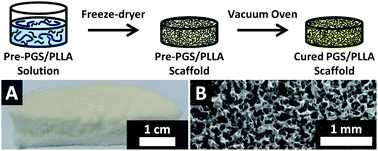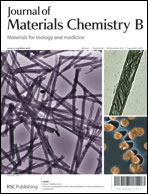Large three-dimensional poly(glycerol sebacate)-based scaffolds – a freeze-drying preparation approach†
Abstract
Large three-dimensional poly(glycerol sebacate) (PGS)-based scaffolds were successfully fabricated via a freeze-drying and a subsequent curing process, in the presence of a minor structure-supporting polymer such as biocompatible poly(L-lactic acid) (PLLA). The resulting PGS/PLLA scaffolds exhibited highly interconnected open-cell structures. The presence of solid PLLA prevented the low-viscosity pre-polymer of PGS from enclosing open cells during the curing stage, thereby avoiding structural collapse of the scaffold. The ratio of PGS to PLLA affected the cell structure and mechanical properties, with a higher ratio of PGS offering a softer and more ductile scaffold in general. The PGS/PLLA scaffold containing 75 wt% PGS presented a porosity of 85%, an average pore size of 93 μm, a Young's modulus of 0.36 MPa, a tensile strength of 0.03 MPa, an elongation at yield of 13%, and good scaffold structure retention during in vitro degradation tests with weight losses of 40% and 9% respectively in 31 days with and without the presence of lipase enzyme. This novel versatile approach will allow for easy fabrication of large, optimal, interconnected porous PGS-based scaffolds for soft tissue engineering.


 Please wait while we load your content...
Please wait while we load your content...